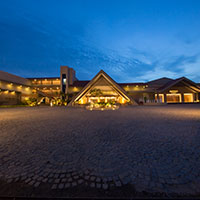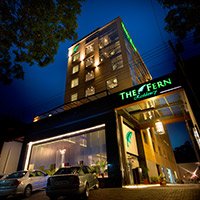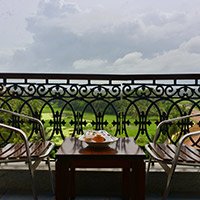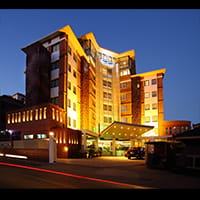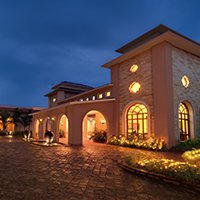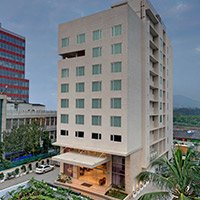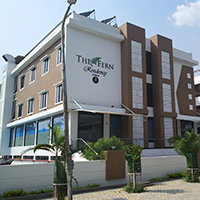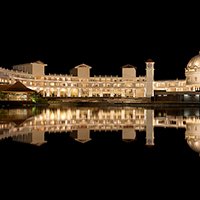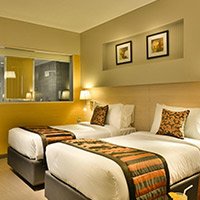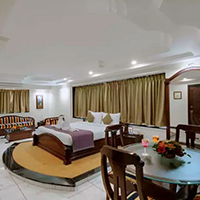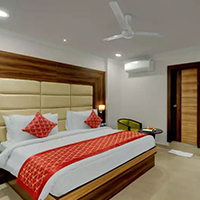The Fern Samali Resort, Dapoli
Hotel in Dapoli
The best resort in Dapoli, The Fern Samali Resort caters to your needs. If you plan to have a relaxed and fun-filled holiday, then dive in to the swimming pool or enjoy the natural surroundings. Have peaceful moments in Amodini, the yoga centre or pamper yourself with a soothing massage and Jacuzzi in the Zion Spa. Jasalina is our Amphitheatre and the venue for wonderful folk dances. A landmark resort in Dapoli, The Fern Samali Resort delivers exceptional service, artful décor and an array of luxury amenities with unparalleled environment responsibility. With a refreshing mix of Indian heritage and high-tech hospitality, we are a leading environmentally sensitive resort in Dapoli, Maharashtra.
- Price Starts from 4597/-
- Distance from 237 km 33 km
- See our reviews

facilities
Experience

Dapoli >
Rare gems of mankind, feathered friends…and more, Dapoli is 5Km from The Fern Samali Resort.

The sea beckons
Maharashtra is blessed with a wonderful coastline that rolls along for about 750 km. lavishly endowed with lush green trees, rustic red mud paths, scintillating sea and soft sensuous sand, the coast draws you deeper and deeper into its enchanting world.
Hindu mythology credits the creation of this coastal countryside to Sri Parshuram who donated the entire earth to mankind, only to realize that he had no land for himself. So, using his divine powers, he shot an arrow into the sea making it recede and thereby creating a landmass. This reclaimed land was called Konkan, and over the years it became an abundant source of cashew nuts, jackfruits, mangoes and several other fruits which grow in plentiful along the hillside. Every village in this region seems to have drawn up a quilt-like velvety covering of several shades of green. Your mind gets boggled by the multi-coloured, multi-textured flowers strewn across the entire region by the magic brush of the Almighty Creator. This gorgeous visual scenario is made even more exhilarating by the divine sights and sounds of rare birds that seem like Angels from Heaven.

Dapoli, the crowning glory of Konkan
It is located about 800 ft above sea level, and hence, it has a cool, healthy and soothing atmosphere prevailing all year round. It is one of the foremost reason why even a weekend in Dapoli is not just relaxing but also rejuvenating. No wonder it has acquired the moniker of “Mahabaleshwar (a renowned hill station) of the Konkan Region”.
Due to its topography and weather, the British made Dapoli their Army Head-Quarters from 1818 to 1857. During this period it was known as Dapoli Camp. In 1880, a Scottish Missionary called Alfred Gadnay started a High School here. It is still considered an important and significant landmark in this region as some of the brilliant luminaries who grew up here, like Sane Guruji and Bharat Ratna P.V. Kane were educated in this school.
The natural beauty of Dapoli is enhanced manifold by its historical and artistic attractions like forts, caves, temples, churches, mosques, mausoleums, ports, lighthouses and other aesthetically appealing architectural marvels with fascinating stories and legends of their own.

Feathered friends of Dapoli
The sea and the creeks between Dabhol and Dapoli are absolute havens for local as well as migratory birds. The sandy coastline from Bankot to Dabhol is home to thousands of seagulls who thrive here, especially during the winter season between September and January. It is indeed a treat to watch these gulls gliding over the energetic effervescence of the sea waves. On the Harne-Murud coastline you are most likely to be privy to the flights of large flocks of the Sandwich Tern, a species of tiny white birds with black feathered crowns.
The densely populated mangroves in this region are truly the treasure troves of birds like the tiny bluish-green Kingfishers, the black-capped Kingfishers, the large stork-billed Kingfishers, and the multi-coloured Oriental Kingfishers. Keen bird-watchers have recently spotted the rare sea blue coloured, white-collared Kingfisher right here.
In addition to these rare bird species, you can also see the thumb-sized white-backed Muniya, the strawberry-like red Muniya, the spotted Muniya, the grayish Great Rid Warbler and many other colourful and attractive bird species.

Ladghar Kolthare >
The reddish sand, a great man’s homeland....and more, Ladghar is 6kms & Kolthare is 10kms from The Fern Samali Resort.

Tamas Teerth, Ladghar
This is actually the name of an unusual looking beach. It’s unusual because it has reddish coloured sand. The word Tamas is a derivative of Tambas which means ‘like copper’, and the word Teerth means holy water. This reddish tinge of the sand also lends itself to the water, which also acquires a reddish hue. Hence the name TamasTeerth. Adding sacred value to this beach are the temples of Sri Veleshwar and the uni-faced Sri Datta. All in all a great attraction for all kinds of tourists
This long winding seashore is dotted with several rocks. You can,t tell how time flies by as you sit on these rocks and watch the waves dance back and forth in perfect rhythm.

Bhagwan Parshuram Statue, Burondi
This awe-inspiring statue is made of Phenocrete. It stands 21 ft high, weighs 5 tons, and is mounted on a hemisphere which has a 40 ft.diameter.

The ‘White’ Beach, Kolthare
The sparkling white sand of the Kolthare beach is in striking contrast to the reddish sandy beach of Ladghar, which gives it a unique and adorable character. The village, and especially its houses, typify the true Konkani style with its sloping roofs and warm, welcoming looks. A lively stream swims down the hills. It is called ‘madhichepani’ which means water from the ‘madh’. This water is blessed with medicinal properties, and it flows into a pond at the southern end of the village where it gets accumulated. Sometimes, in the jungle
surrounding this area, you can see peacocks. There is also a hill nearby where the sea has been constantly chipping away at the rocks for years, creating a deep cavity. It is locally known as ‘Ghalai’. During high tides, the sea storms into this cavity and leaps upwards to form a towering column of water, and the booming sound that accompanies it sounds like a thunderous applause. Towards the northern end of the seashore a natural cave has been created. It is known as ‘Vaghbeel’ or a Tiger’s Cave. As you walk down this part of the beach, your feet are pampered by the extremely soft and silky touch of the sand. The Madan river can be seen from here.

LokmanyaTilak Temple, Laxmi-Keshav Temple, Chikhalgaon
LokmanyaTilak, one of the leading freedom fighter in India’s battle against the British, is the pride and joy of Chikhalgaon village. His original ancestral place of abode is now venerated, and a divine Tilak temple has been built on a part of its premises. A temple dedicated to Laxmi-Keshav, the presiding family deity of the Tilaks, has also been built amidst the thick foliage along a stream that runs down the village.
A place that you must visit is the impressive educational institution built by the eminent Dr. Raja and Renu Dandekar. It encompasses the LokmanyaTilak High School which conducts courses in technical education, Hostels for boys and girls, Library, Cultural Center and Healthcare Center. This dedicated couple has been disseminating all these services and facilities for the benefit and progress of children, both boys and girls, not only from nearby villages but even from distant areas. The Tilak temple and some key structures within this educational institution have been designed by the iconic British architect Laurie Baker.

Harne Anjarle >
Port, Forts, Seashore... and more, Harne is 15km & Anjarle is 18km from The Fern Samali Resort.

Suvarnadurg Fort, Harne
This unusual fort is located almost a mile away from the seashore, and sprawls across two acres.It was captured by ChhatrapatiShivajiMaharaj in 1660, and rebuilt extensively. Some claim that it was originally built by the Adilshah’s of Bijapur, but some believe that its antiquity dates back even further to the Shilahar era.
The massive almost impregnable fort has rock solid ramparts, with 15 bastions and 2 gates. The first gate is so cleverly concealed within the fortification that one can see it only at very close proximity of the fort. This strategic architectural advantage ensured that enemy ships could not identify the exact entry point to the fort from the distant seas. Even today, one has to take a boat ride from the shore, land at a sandy stretch, and only then can you enter the Suvarnadurg fort. The other gate is called the ‘chordarwaja’ or hidden gate, and is located on the western side. Steps have been built to descend down from the fort to the gate.
The Suvarnadurg fort was witness to the phenomenal achievements of the great Maratha Naval Chief Kanhoji Angre. Initially his father was the Second-in-Command of the fort. This was the time when Chhatrapati Shivaji Maharaj’s son Sambhaji ruled the Maratha Kingdom.

Gova Fort, Harne
This fort is located on the east, as you proceed towards the Harne port. You can see the gateway to the fort amidst the black stone walls. At the base, on either side of the gate, you can see sculptures of tiger-like creatures called ‘Vyals’; on the left side is a unique sculpture of ‘Gandabherood’, the mythical bird holding 4 elephants in its claw-like grip, and on the right side are carvings of elephants. You can climb up the steps to the ramparts and watch the reflection of the Suvarnadurg fort in the water and enjoy the waves riding up and down to the walls of the fort in a natural rhythm. It is a wonderful sight. The sunset behind the Suvarnadurg fort is truly picturesque,but what makes it a photographer’s delight is the number of angles and perspectives that one can get from here.

The Lighthouse, Harne
There are steps from the Kanakdurg fort leading up to the lighthouse which is more than a 100 years old. It is probably the oldest lighthouse that is still operational along the Konkan coast of Maharashtra, and is a real boon for the fishing community of this area.
You can get a spectacular panoramic view from the top of this lighthouse spanning the Suvarnadurg, the Harihareshwar mountains, the Ganpati temple-on-a-cliff (KadyavarchaGanpati),the Harne port, the seashore of Murud-Karde, right up to the Dabhol creek.

Harne Port
In the early days, when there was hardly any mode of transportation, Harne port was an important location for seafarers. Today it is one of the hubs for the fishing business. One of the most interesting and intriguing sights here is the auction of the day’s fresh catch, which is organized every evening between 4 and 7 pm. Fish worth lakhs of rupees are traded here and even exported.
The route to the Harne port is lined with boats that are being built, maintained and repaired all along the pathway.

Kadyavarcha Ganpati, Anjarle
This literally means Ganpati-on-the-cliff, and represents the location of the Ganpati temple which is located on a cliff. It was originally built in 1430, and had a wooden structure. But the temple, as it stands now, was rebuilt in 1780, and is an eloquent testimony to the architectural excellence of the Peshwaera. The basis construction consists of the sanctum sanctorum, the prayer hall and the assembly area. There are three entrances to the area encompassing the prayer and assembly halls. The temple also has a large dome above and a very artistic spire adorns the top of the sanctum sanctorum. The Ganpati idol is about 31/2 – 4 ft. high with the trunk pointing to the right, a cobra encircling the waist, and has an axe (Parsha) and a goad (Ankush) in each hand. Idols of Riddhi Siddhi have been carved alongside. Outside the temple you can see 4 Bakul or Bulletwoodtrees growing and glowing in each corner of the compound.These trees are believed to be about 600 years old. A large water tank has been excavated in the rocky ground right in front of the temple. There is also an attractive pillar of lights (Deepmala) facing the temple and a protective boundary wall surrounding the entire temple.

Ade & Kelashi >
Temple Towns, Seashore… and more, Ade is 21km & Kelashi is 25km from The Fern Samali Resort.

Parshuram Temple Complex, Ade
This is a unique phenomenon. Nowhere else in Konkan will you see such a temple complex. As you proceed from Ade village to Kelashi, you can see a flight of steps on your right. On climbing up these steps for about 10-15 minutes, at a comfortable pace, you come across a cluster of 5 temples, all of them facing the East. The architecture of these temples is reminiscent of the Peshwa era. But the local residents believe that they are even more ancient.
The Parshuram temple is believed to be the most significant one among these 5 temples. On the right side of this temple is the Shankar-Renuka temple, and on its left side are the Maruti temple, the Ganpati temple and the Vetal and Shani temple. There is a huge pond located on the left of this temple complex. In the whole of Konkan, there are only two temples dedicated to Lord Parshuram, the other one being in Chiplun.
There is quaint coconut and palm tree lined pathway through the village that leads to the seashore. The beach is vast and very beautiful. Right next to the beach is a ‘mini forest’ of fragrant screw pine or ‘Kevada’ trees. When these trees bloom around August and September, their fragrance spreads right across the entire seashore.

Mahalaxmi Temple, Kelashi
At the southern end of Kelashi village, there is a mountain called Utambar. The Mahalaxmi temple is located at the base of this mountain. The temple faces the north and has a typical Peshwa era architecture. There is a well and a lotus pond within the precincts of the temple. Steps have been built to lead up to the pond.
The lush green forests covering Utambar mountains make a beautiful backdrop for this temple giving it a wonderful aura.
During the auspicious period between eighth crescent lunar day and the full moon of spring(Chaitra Shuddha Ashtami and Poornima), a huge fair is celebrated here, and the event is a big attraction for people from all over Maharashtra. Similar celebrations are also enjoyed during the nine days (Navratri) before the ‘Dasara’ festival. Traditional folk songs, dances and music like ‘Gondhal’, ‘Kirtan’, ‘Bhajan’ are performed with full vigour and authenticity. The chariot procession, or ‘Rath Yatra’ is one of the highlights of the celebration. These festivities are organized and celebrated by the entire village as one cohesive unit, irrespective of caste, creed, religion, age, gender or financial status.

Sand Hill, Kelashi
A rare sight awaits you along the seashore, where a hill is seen rising right next to the sea. Recently, archeologists have discovered some ancient artifacts under this hill. And excavation continues as more and more interesting and enlightening findings come to light. But all this hustle-bustle and hectic activity has not stopped young children from enjoying the slide down this velvety slope.

Asud Murud Karde >
Impressive temples, uncluttered beaches, water sports… and more, Asud is 8km, Murud is 11km & Karde is 12km from The Fern Samali Resort.

Asud Baug
Asud is a calm and serene village lying peacefully under a dense canopy of coconut and betel nut palms which seem to kiss the sky, while little streams go twinkling down the slopes of the hill on which it is located. Mother Nature rolls out its floral carpets of many hues, while the morning greets you with a melodious orchestra of sweet and soothing tweets of different colourful birds in all their finery. A typical sight that greets you in the village is that of betel nuts scattered all around and various household goodies from kitchens being spread out on rooftops and terraces to dry under the sun.

Keshavraj Temple, Asud
This temple is perched on a hill, and the best way to get there is by walking through the pretty village of Asud. Get off the main road and walk down to the stream, cross the little bridge across the stream and climb up for 10-15 minutes up the stone steps to reach this lovely temple. You’ll be greeted by a cool breeze which will simply blow away all the fatigue caused by the steep ascent. The dense foliage of trees on all four sides of this temple precinct gives it an aura of blissful solitude. The architecture of this temple harks back to the Peshwa era, and its frontage faces the south. The idol of Sri Vishnu, the presiding deity of this temple, glows in the dim light of a solitary pedestal lamp. One of the major highlights of this temple is the constantly flowing water from the mouth of a cow ( ‘Gomukh’) carved in stone. The flowing water originates from the hill on which this temple is located. This phenomenon has lasted from time immemorial and still continues all year round.

Karde Beach
On the main road leading to Murud village, take a left turn to go to the naturally blessed seashore of Karde. It is a safe and peaceful beach where you can just sit for hours appreciating and admiring the scenic beauty of the sea as thousands of seagull soar into the sky. A fascinating experience awaits you if you take boat ride into the deep sea where Dolphins win over your hearts by their swimming and diving skills. But during the monsoons, boat rides are forbidden as the sea is very choppy and unsafe. In winter, Harne, Murud and Karde turn into ‘guest houses’ and ‘holiday resorts’ for thousands of migratory birds.

Dapoli, Jaalgaon Gavhe >
Agricultural University, Nursery Village… and more, Jaalgaon and Gavhe are 5kms from The Fern Samali Resort.

Dr. Balasaheb Sawant Konkan Agricultural University, Dapoli
This landmark University was established on May 18, 1972 in Dapoli to create a fountainhead institution which would enhance and enrich the knowledge capital in the field of agriculture through education, research and development, especially for the Konkan region covering Mumbai, Thane, Raigad, Ratnagiri, and Sindhudurg districts. The institution conducts courses in Agricultural Science, Agricultural Engineering and Fish Farming with special emphasis on agricultural research and development of innovative methods of cultivation. There are many such ongoing projects and many more are on the anvil. Fruit cultivation is one of the most prolific agricultural activity in the Konkan region. The University has not only recognized this fact, but has also responded with all the energy, enthusiasm and a sound scientific approach. This has resulted in the cultivation of new varieties of mangoes like ‘Ratna’, ‘Sindhu’, and ‘Konkan Ruchi’. The University has also developed new breeds and appropriate methods to cultivate these breeds of cashew nuts, coconuts, chikoos (sapots), ‘karvanda’(blackberries) and ‘kokum’.

Nursery Village, Gavhe
Large and small nurseries pervade this pretty little village. Here you can see and buy more than 800 varieties of saplings and plants including those of mangoes and other fruits, vegetables, flowers, both indoor and outdoor decorative plants. KOP’s and Amrute’s nurseries specialize in medicinal herbs and plants

Velas Bankot Palgad >
Olive Ridley Turtles, Sane Guruji’s Memorial...and more, Velas is 44kms, Bankot is 60kms & Palgad is 23kms from The Fern Samali Resort.

Olive Ridley Turtles, Velas
The calm and naturally blessed seashore of Velas becomes the abode and breeding ground for the endangered Olive Ridley Turtles all through the summer and immediately after winter. Thousands of these huge turtles come here to nest and procreate, and thus multiply in numbers. Since 2003, the SahyadriNisargaMitra organization has undertaken a project to protect the nests and promote and propagate their mission to save this rare species. Over the years this movement has gathered a lot of momentum, so much so that Velas is now known as the village of Olive Ridley Turtles.

Himmatgad Fort, Bankot
Bankot is the termination point of the southern end of Ratnagiri district .Bankot has been referred to as Mandgor orMandargiri by the reputed Greek philosopher Pliny in the 1st Century AD. The Himmatgad fort is located on top of a hill which is at the southern end of the Savitririver. In 1548 this fort was won over by the Portuguese from the rulers of Bijapur, only to lose it to the Marathas in the mid 16thCentury.Commodore James of the British armed forces won over Himmatgad from the Marathas and decided to call it Fort Victoria. Bankot and the Himmatgad fort continued to play a pivotal role for seafarers even during the British rule.
A panoramic view from the top of the fort covers the Harihareshwarmountain across the river, and stretches right from Harne-Murud right up to Srivardhan, making it a vantage point to observe and maintain a vigilance on the navigational activities in the region.

Ferry Boat Service, Bankot
There is a village called Veshvi which is very close to Bankot. Veshvi is well known for its Ferry Boat Service that can transport you to Diveagar via Harihareshwar and Srivardhan. The service includes transportation of vehicles as well : right from 2-wheelers to tourist buses and trucks can be ferried from Veshvi or Bankot to Bagmandale which is on the opposite bank of the river. This crossing takes you from Ratnagiri district to Raigad district. Harihareshwar is only 4 km from Bagmandale. In case you want to go further to Srivardhan, Diveagar or even Murud-Alibaug, then this is a much shorter route.For further details on how to avail of the Ferry Boat Service, contact – 02350 223300. There is also a facility here to book a boat for private groups as well.

Palgad Fort
The word ‘Pal’ means lizard and since the fort is shaped like a lizard’s head it is called Palgad. In the early days it was also called ‘Pallil. The Palgad village is very close to the fort which is in shambles, with a couple of cannons lying around suggesting the warring days and ways of yore. But the place is a trekker’s delight as the climb up the hill through the dense forest can be quite exciting. However it is advisable to know the correct routes and pathways before embarking on this trek.

Panhalekaji Unhavare >
29 Caves, Hot Water Springs… and more, Panhalekaji Unhavare is 40km from The Fern Samali Resort.

Panhalekaji Caves
As you drive down the Dapoli- Dabhol road for about 5 km, you see a bifurcation on the left near the Nanate village, which goes to Panhalekaji. Along the banks of Kotajai river,you can see 29 caves excavated within the hills. This river is ‘S’shaped with hills on either sides and dense green foliage, making it a pretty picture.
One of the significant aspect of these caves is that 28 of them face the north while the 29th one, which is a little further, near Mathavali, is known as ‘Gauralene’. A unique feature of these caves is the coexistence of images representing the Heenayaan Buddhist sect, the Tantric Vajrayaan sect and the Nath sect, along with idols of Hindu Gods like Sri Ganpati, Sri Laxmi, Sri Saraswati and the ‘Shivaling’ which is a symbolic representation of Lord Shiva. The initial process of excavation commenced in the 2nd and 3rd Century AD. During this period, the Heenayaan Buddhist sect was already in existence. Later on, the caves excavated in the period between the 8th and 11th Century provided evidence that the Tantrik Vajrayaan sect had the upper hand during this period.

Hot Water Springs, Unhavare
Dapoli-Khed road has a right turn at Vakavali village which leads up the ‘ghat’(hilly region) via Gavatale, straight to Unhavare village. When you reach the top and look down the valley, you can enjoy a breathtaking view of the lush green hills with a river meandering along, crops swaying to the tune of the whistling wind, and houses sprawled across the hilly slopes. This fabulous view will automatically draw you towards the village.
However, the biggest attraction of Unhavare are the Hot Water Springs where boiling hot water comes up through the ground and is eventually collected in three vast tanks. The Sulphur content in these hot water springs have healing properties which is supposed to cure various skin ailments. The main spring throws up boiling hot water, and you can actually see bubbles popping up from underground through the clean and clear water. The heat generated by these hot springs makes the surrounding ground area also extremely hot. Over the years, these springs have become a place of worship, and hence, you have to go there barefoot.

Dabhol >
A Historic Port and more, Dabhol is 30 km from The Fern Samali Resort.

The evolution of Dabhol over the ages
Dabhol is arguably the oldest and best known port along the western coastline of India. It has a distinct mention in the maps of Ptolemy, the Greek astrologer and geographer whose lifetime spanned from 90 AD to 168 AD.
It is believed that Dabhol derived its name from the ancient sage Dalabhya. History states that Dabhol was mostly ruled by the 'Chauls',the 'Shilahars' and other Hindu dynasties until the thirteenth century.
Over the years Dabhol has been bruised and battered by several invasions and wars, leading to constant changes in its name and character, from. It has been destroyed or badly damaged by a number of invaders, but it has risen like the proverbial Phoenix, in a different 'avatar' each time. It was first known as Dalabhyapuri, and then Dalabhyavati, and even Mahikavati. Later on, during the Muslim reign, it was called Hamzabad and Maimunabad.

Chandika Devi Temple
There is a certain mystique attached to this temple because it is believed that it was 'created' by the forces of nature or some unknown divine powers. It is believed that the temple and its presiding deity were neither built nor sculpted, nor installed,but discovered. Of course, archeologists have a different point of view.
The actual temple is a naturally formed monolithic cave which has a 3 1/2 foot idol of Chandika Devi in black rock adorned with an orange pigment called 'Shendoor'. The entrance to this temple is so narrow that you are compelled to bend over in order to enter. The entire passage is completely dark,and one tends to get disoriented while trying to figure out which path to take to go towards the inner sanctum of the temple. But as you slowly navigate your way through this dark passage, you can see a soft glow of light emanating from a pedestal lamp called a'Samaee' which lights up the idol of Chandika Devi in all its glory. The other object that catches your eye is a sword which is kept close to the idol. Devotees believe that this sword was dedicated to the Goddess by Chhatrapati Shivaji Maharaj.

Dabhol Harbour
The hustle and bustle of the Dabhol harbour has to be seen to give you an insight into this trade and business hub where commerce meets enterprise. It is also meeting point of the sea and the river Savitri which comes down from Chiplun, to form a creek.
The view around the harbour is quite picturesque. Across the creek you can see the villages of Veldure and Dhopave. The Gopalgad fort welcomes you at Anjanvel. You can climb from the village itself, or you can take a boat ride to Dhopave, from where there is a motorable road right up to the fort. The choice is entirely yours. At night, it is fascinating to see the bright beams from the lighthouse, running across from one side to the other and back in quick succession.
Today the pristine beauty of Dabhol is accompanied by the inevitable symbols of the modern times,like the chimneys and other structures of the Enron Power Project.




















